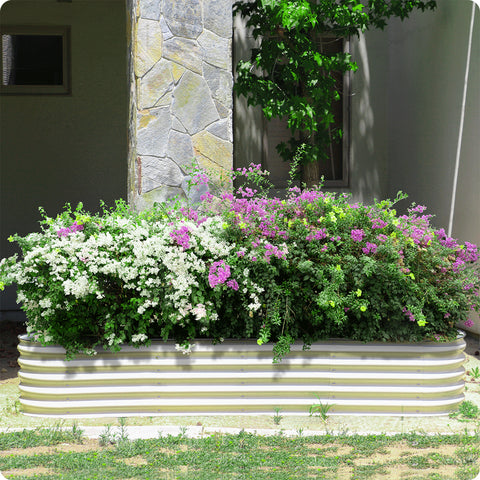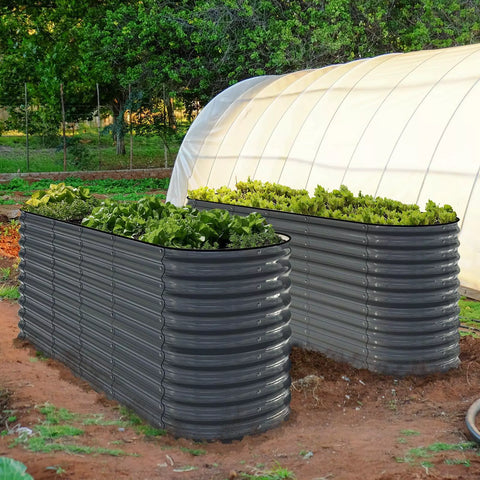Tips from Olle Garden Bed: How To Refresh Old Garden Covers
Covering plays a crucial role in maintaining successful and healthy gardens. It has various benefits, such as soil erosion prevention, water retention, temperature regulation, and weed control. In addition, when natural covers decompose, they release nutrients into the soil, thereby improving its health, fertility, and structure. The following content also has some reference value for raised garden beds.

Despite these advantages, the cover will deteriorate over time, lose color, decompose, and become compacted. So, what can you do to refresh your old garden cover? Do you need to consider any specific things before doing so? What is the most popular technology for this project?
Assess the condition of the cover
It is important to evaluate the current status of the cover before refreshing it. This will enable you to determine the best way to renew the mulch, as the service life of various mulch materials may vary depending on your local climate and soil type.
Firstly, check the depth of the covering layer. Its thickness should be between 2 and 4 inches. If it exceeds this range, it may lead to waterlogging problems and insufficient air circulation, thereby strangling the roots of plants. On the contrary, thinner layers will not provide sufficient coverage or security. If you find that the covering layer has become too thin, it's time to replenish it.
Note: Do not mix organic and inorganic mulch, as organic mulch will decompose over time, making the soil rich in nutrients, while inorganic mulch will not. Combining the two can lead to unequal decomposition, thereby damaging plant growth. In addition, mixing different types of coverings can create uneven surfaces, making it more difficult to control soil moisture and temperature levels.
After evaluating the depth of the coverage layer, the next step is to check its texture. It is important to ensure that the cover is not compacted, as this may lead to root rot, poor ventilation, mold and fungi, and hinder plant growth. If your cover is compacted, use a rake or hand trowel to break it down, loosen it, and improve its texture.
Finally, check the color of the cover. As time passes, the cover will lose its color and appear gray or faded, making your garden look dull and lifeless. Fortunately, there is a solution to this problem - you can refresh the color of the cover!
How to refresh old garden covers
Now that you understand how to evaluate the condition of the cover, it's time to take a look at the most common methods for refreshing the cover.
Technology 1: Fluffy and loose
One of the most common problems with covering is compaction, which can seriously damage your plants. Depending on the amount of cover you need, use a rake or hand trowel to loosen and fluff it to improve its breathability and texture.
Firstly, use a rake to gently break any lumps or mats in the cover. When you use it, please remove any debris, such as branches and twigs, as this may cause future compaction problems. Add any organic debris you have removed to the compost pile.
Attention: Be careful not to rake too hard, as you may damage the roots of the plant.
Technology 2: New Layer
The effectiveness of organic coverings will decompose and decrease over time. For inorganic coverings such as rubber, stone, and pebbles, this is not a problem unless you scatter them in areas with high pedestrian traffic, such as trails, boundaries, and courtyards.
If your cover height is less than 2 inches, it is time to add a new layer, but please ensure it does not exceed 4 inches. Please remember to leave a gap of 1 or 2 inches between the plant stem or trunk and the cover to prevent water accumulation due to poor aeration.
After applying a new layer, gently rake in until there are no lumps or pads in the area, forming a uniform layer.
Note: Before adding a new layer, please remove any debris, dead plants, or weeds from the area to maximize the benefits from covering.
Technology 3: Coloring
Frequent exposure to sunlight can cause the color of the cover to fade, and when this happens, it does not necessarily mean that it is useless or that you need to replace it. Sometimes, all you need is color, but not just any type of color. You can use two types of dyes in the garden - carbon based dyes and iron oxide dyes.
Flower shops and businesses that handle large quantities of flowers often use iron oxide dyes to color the flowers. In addition to flowers, iron oxide dyes are also used in cosmetics. You can even use carbon based dyes to color the covering, as they are similar to dyes used in many products, including belts, tires, and other rubber products.
If you are interested in viewing iron oxide dyes, please check out the iron oxide powder in the Hui Xiang store on Amazon. There are eight colors and three sizes to choose from, and you will definitely find the perfect shade for your garden cover.
On the other hand, it is important to verify the supplier and source of carbon based dyes when selecting them. Ensure that they do not use chemically treated materials to produce dyes, as this may contaminate your cover and harm your plants. Please consult the private environmental testing laboratory in your area to ensure that the dye does not contain harmful chemicals.
Love with coverage!
Covering is an excellent method for promoting plant health, preventing soil erosion and weeds, and improving soil water retention, which is why it is widely popular among horticultural enthusiasts. However, over time, the covering layer may become compacted, depleted, or lose color.
When this situation occurs, depending on the problem, you can fluff the cover, supplement it, or make colorful modifications to it. If you decide to color the cover, please ensure that the dye does not contain chemicals to protect your plants from exposure to toxic substances.
Have you tried these methods before? If so, which one is suitable for you?

